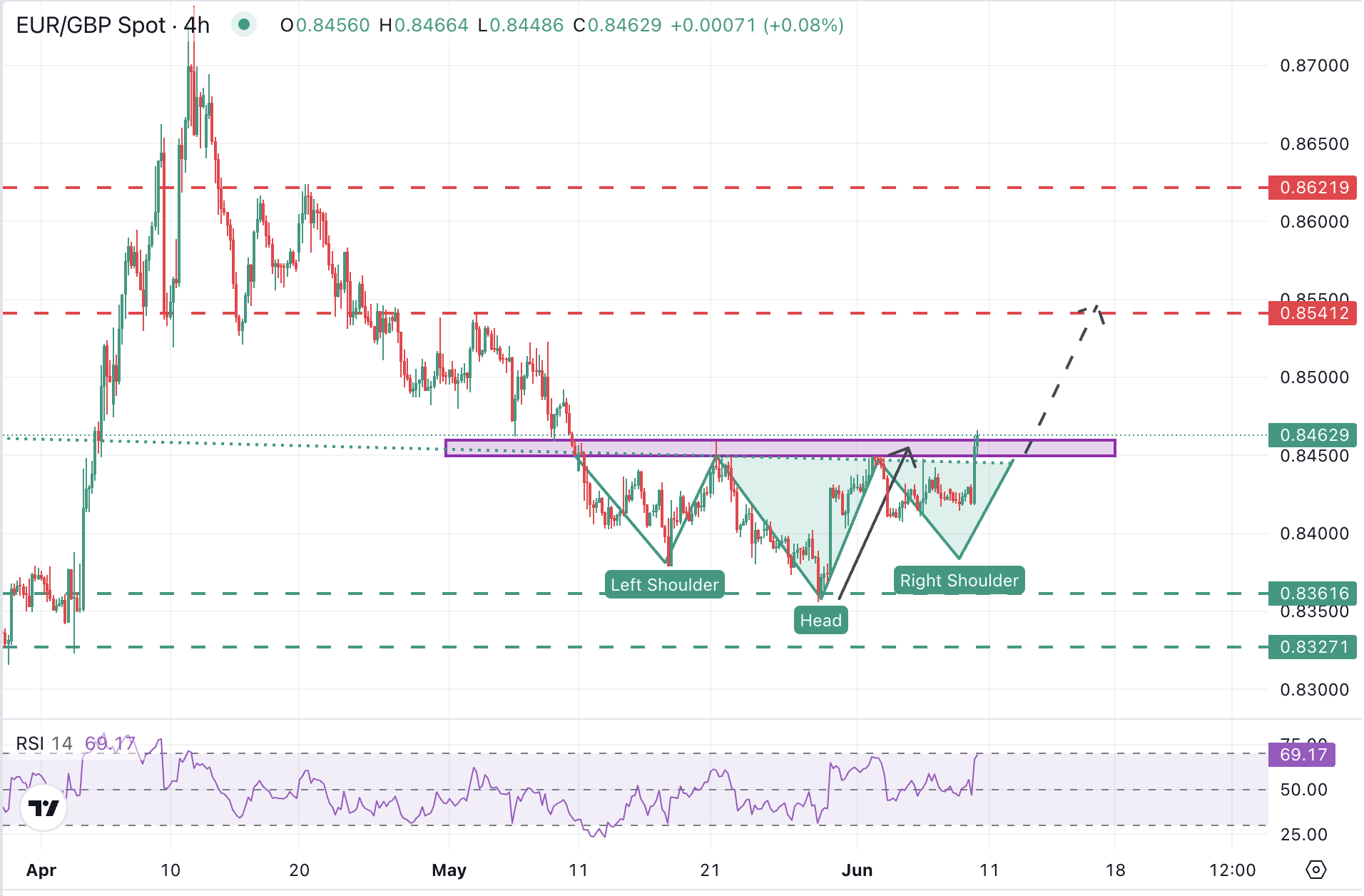EUR/GBP explores one-month highs above 0.8460 with the Pound on the defensive
- High UK unemployment and low wage growth figures are weighing on the Pound.
- The Euro is drawing support from upbeat Eurozone data and hawkish ECB speak.
- The pair is testing the neckline of an inverted H&S, at 0.8460.
The Euro is rallying against a weaker Pound on Tuesday, with bulls pushing against the top of last month’s trading range, at 0.8460, favoured by weak UK employment figures and positive data from the Eurozone.
Data from the UK released earlier on Tuesday revealed that the Unemployment Rate increased to 4.6% in May , its highest level in four years, with claimants of jobless benefits increasing by 33.1K in May, more than three times the 9.5K increment foreseen by market analysts.
Beyond that, wage growth slowed to 5.2%, from the 5.5% growth posted in April, below the 5.4% reading anticipated by the market consensus. These figures pave the path for the Bank of England to ease monetary policy further, and have pushed the GBP lower across the board.
Eurozone data, on the other hand, has beaten expectations with Investors' confidence reaching one-year highs and Italian Industrial Production growing well beyond forecasts. Apart from that, hawkish comments from ECB’s Rehn and Villeroy have provided additional support to the Euro.
Technical analysis: EUR/GBP testing the neckline of a bullish H&S
From a technical standpoint, the pair is about testing a previous support, now turned resistance, and the neckline of an inverted Head and Shoulders pattern, at the 0.8450-0.8460 level.
The measured target of the H&S pattern is at the 0.8540 area, which is coincident with the April 25, 30, and May 2 highs. Above here, the next target is the April 21 high, at 0.8620.
On the downside, a bearish reaction below 0.8360 cancels this view and increases pressure towards 0.8325 (April 3 low) and the key 0.8245 year-to-date low.
EUR/GBP 4-Hour Chart

Pound Sterling FAQs
The Pound Sterling (GBP) is the oldest currency in the world (886 AD) and the official currency of the United Kingdom. It is the fourth most traded unit for foreign exchange (FX) in the world, accounting for 12% of all transactions, averaging $630 billion a day, according to 2022 data. Its key trading pairs are GBP/USD, also known as ‘Cable’, which accounts for 11% of FX, GBP/JPY, or the ‘Dragon’ as it is known by traders (3%), and EUR/GBP (2%). The Pound Sterling is issued by the Bank of England (BoE).
The single most important factor influencing the value of the Pound Sterling is monetary policy decided by the Bank of England. The BoE bases its decisions on whether it has achieved its primary goal of “price stability” – a steady inflation rate of around 2%. Its primary tool for achieving this is the adjustment of interest rates. When inflation is too high, the BoE will try to rein it in by raising interest rates, making it more expensive for people and businesses to access credit. This is generally positive for GBP, as higher interest rates make the UK a more attractive place for global investors to park their money. When inflation falls too low it is a sign economic growth is slowing. In this scenario, the BoE will consider lowering interest rates to cheapen credit so businesses will borrow more to invest in growth-generating projects.
Data releases gauge the health of the economy and can impact the value of the Pound Sterling. Indicators such as GDP, Manufacturing and Services PMIs, and employment can all influence the direction of the GBP. A strong economy is good for Sterling. Not only does it attract more foreign investment but it may encourage the BoE to put up interest rates, which will directly strengthen GBP. Otherwise, if economic data is weak, the Pound Sterling is likely to fall.
Another significant data release for the Pound Sterling is the Trade Balance. This indicator measures the difference between what a country earns from its exports and what it spends on imports over a given period. If a country produces highly sought-after exports, its currency will benefit purely from the extra demand created from foreign buyers seeking to purchase these goods. Therefore, a positive net Trade Balance strengthens a currency and vice versa for a negative balance.

